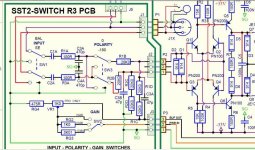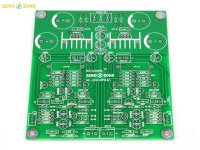Thank you.... I will use Takamisawa relayGüzel fotoğraflar Sensation45. 😎
Merhaba (Eng: Hi) Sensation45!
Very good. I have some other relays from Schrack, reliable industrial grade parts. It is important to have reliable quality relays.
Have you got UPC 1237? I have several left-over from my Accuphase A60+ project.
Good luck!
Very good. I have some other relays from Schrack, reliable industrial grade parts. It is important to have reliable quality relays.
Have you got UPC 1237? I have several left-over from my Accuphase A60+ project.
Good luck!
I have upc1237s from sony and onkyo amps. I will use them. Thank you for your opinion.Merhaba (Eng: Hi) Sensation45!
Very good. I have some other relays from Schrack, reliable industrial grade parts. It is important to have reliable quality relays.
Have you got UPC 1237? I have several left-over from my Accuphase A60+ project.
Good luck!
Sensation45, Pay attention to the C3 (47pf) at the entrance. Low-pass filter at 170kHz, protects the output stage from through-current. He's not in the clan!
Attachments
I have a Bryston 4B that just lost one channel. It was purchased on the assumption that Bryston had class-leading support (whether or not the product is still under warranty). . . but, for the last 3 days, I have been unable to reach any human at Bryston by way of phone or web contact form. So, I find myself reading this thread from top to bottom. I need an operational 4B, and even with component matching deficiencies, it seems a clone can be made that produces audio on 2 channels and quite well. . . possibly for a comparable cost to what the repair/refurbish bill would end up being if I can get in touch with anyone at the company. I am not electronically literate, but am a monkey with a soldering iron that has built microphones, preamps, EQ's, and compressors of various flavors for music production with a high rate of success and relatively little magic smoke being released because my mechanical skills are decent and I'm relatively good at being cautious and thorough. Reading through this thread has been a hoot even if I only understand 5% of the content, and I'm wondering if it is feasible to consider the clone option.
I have a Bryston 4B that just lost one channel. It was purchased on the assumption that Bryston had class-leading support (whether or not the product is still under warranty). . . but, for the last 3 days, I have been unable to reach any human at Bryston by way of phone or web contact form. So, I find myself reading this thread from top to bottom. I need an operational 4B, and even with component matching deficiencies, it seems a clone can be made that produces audio on 2 channels and quite well. . . possibly for a comparable cost to what the repair/refurbish bill would end up being if I can get in touch with anyone at the company. I am not electronically literate, but am a monkey with a soldering iron that has built microphones, preamps, EQ's, and compressors of various flavors for music production with a high rate of success and relatively little magic smoke being released because my mechanical skills are decent and I'm relatively good at being cautious and thorough. Reading through this thread has been a hoot even if I only understand 5% of the content, and I'm wondering if it is feasible to consider the clone option.
I read a post somewhere, recently, that Bryston may be moving offices, and are subsequently hard to get hold of using the usual methods. Try contacting them through their Audiocircle forum, https://www.audiocircle.com/index.php?board=57.0.
I can confirm that the build is fairly straight forward. Take your time check the pin outs on any substitute components and match the relevant ones as per the build instructions and you will have a great sounding amplifier. I built mine at the same time as an AMB B24 and restoring a Krell KSA100 all three being high end amplifiers, but in my system the Bryston worked the best and has been used every day since!I have a Bryston 4B that just lost one channel. It was purchased on the assumption that Bryston had class-leading support (whether or not the product is still under warranty). . . but, for the last 3 days, I have been unable to reach any human at Bryston by way of phone or web contact form. So, I find myself reading this thread from top to bottom. I need an operational 4B, and even with component matching deficiencies, it seems a clone can be made that produces audio on 2 channels and quite well. . . possibly for a comparable cost to what the repair/refurbish bill would end up being if I can get in touch with anyone at the company. I am not electronically literate, but am a monkey with a soldering iron that has built microphones, preamps, EQ's, and compressors of various flavors for music production with a high rate of success and relatively little magic smoke being released because my mechanical skills are decent and I'm relatively good at being cautious and thorough. Reading through this thread has been a hoot even if I only understand 5% of the content, and I'm wondering if it is feasible to consider the clone option.
P.S are you the same chunger as the one over on group diy? If so I have followed your AKG C12 build with great success!
Hi Trampo,I can confirm that the build is fairly straight forward. Take your time check the pin outs on any substitute components and match the relevant ones as per the build instructions and you will have a great sounding amplifier. I built mine at the same time as an AMB B24 and restoring a Krell KSA100 all three being high end amplifiers, but in my system the Bryston worked the best and has been used every day since!
P.S are you the same chunger as the one over on group diy? If so I have followed your AKG C12 build with great success!
This is indeed the same chunger from GroupDIY! I'm glad the C12 worked out. I try to the best of my abilities to document any project that I attempt clearly enough that a complete newbie has a chance to tackle it. I'm trying to gather the necessary courage for this one because I think it has fantastic utility. But I have a lot of questions even before deciding to press the go button. I'm gonna read through the thread in entirety one more time so I don't ask silly things that have already been covered in detail.
I have just upgraded my transformer in my 4b clone after using a temporary smaller lower voltage transformer. The old transformer ran at about 45Vand the amp has been used every day for a couple of years now, The new transformer runs at 68V and I now cant keep the bias down on the output transistors with the input board connected. If I disconnect the input board all is fine, as soon as the input board is connected the bias voltage starts climbing and of course the amp heats up. The DC offset voltage on both the input board and output of the main board (when not connected together) is about 4mV, so no issues there.
I noticed in the debugging document it mentions if using higher voltages to re-adjust the current to the unbiased flow and adjust the current and midpoint, not really sure what this means but I assume I need to do this to get the amp working properly again.
Can any help or point me in the right direction?
Many thanks Trampo
I noticed in the debugging document it mentions if using higher voltages to re-adjust the current to the unbiased flow and adjust the current and midpoint, not really sure what this means but I assume I need to do this to get the amp working properly again.
Can any help or point me in the right direction?
Many thanks Trampo
Problem solved!I have just upgraded my transformer in my 4b clone after using a temporary smaller lower voltage transformer. The old transformer ran at about 45Vand the amp has been used every day for a couple of years now, The new transformer runs at 68V and I now cant keep the bias down on the output transistors with the input board connected. If I disconnect the input board all is fine, as soon as the input board is connected the bias voltage starts climbing and of course the amp heats up. The DC offset voltage on both the input board and output of the main board (when not connected together) is about 4mV, so no issues there.
I noticed in the debugging document it mentions if using higher voltages to re-adjust the current to the unbiased flow and adjust the current and midpoint, not really sure what this means but I assume I need to do this to get the amp working properly again.
Can any help or point me in the right direction?
Many thanks Trampo
Installed 68pF caps into C16 and C17 on the input board. The extra voltage must have made it oscillate.
Ok, I solved it. When viewed from the Philips front side, the 3rd Leg is marked as the 1st Leg.Hi Sensation45
This is known issue with "Chinese" cbe 5551/5401. These are in fact CDIL (India) variants with "swapped" pinout.
Look HERE. Just use what you have and bend their leads accordingly before soldering.
Merhaba Sensation45
Bu, "Çinli" cbe 5551/5401 ile ilgili "bir sorundur. Bunlar aslında "değiştirilmiş" pin çıkışlı CDIL (Hindistan) varyantlarıdır.
BURAYA bakın . Sadece sahip olmalarınızın önceliğini kullanın ve bunlara uygulanmadan uçlar için bükün.
Berlusconi Thank you I have these philips, they are the same as ONSEMI 2n5401 when viewed as 1 foot from the front.Hi Sensation45
This is known issue with "Chinese" cbe 5551/5401. These are in fact CDIL (India) variants with "swapped" pinout.
Look HERE. Just use what you have and bend their leads accordingly before soldering.
Berlusconi: did you finish 4b sstHello hschier,
Have you tried a 2sc5200/2sa1943 pairs? Are there any problems with "faster" devices?
No, I have purchased boards but now Iwork on several other projects (*) and build DIY housings for my amplifiers.Berlusconi: did you finish 4b sst
(hifi four chanel amp based on STK 4042XI ICs, 22W JLH 2005, chazis for Krell KSA-50 Mk. II, Accuphase A60, Linkwitz-Rilley active crossover... etc... Lots of fun)
Merhaba sevgili arkadaşım
- Home
- Amplifiers
- Solid State
- Bryston 4B SST clone

